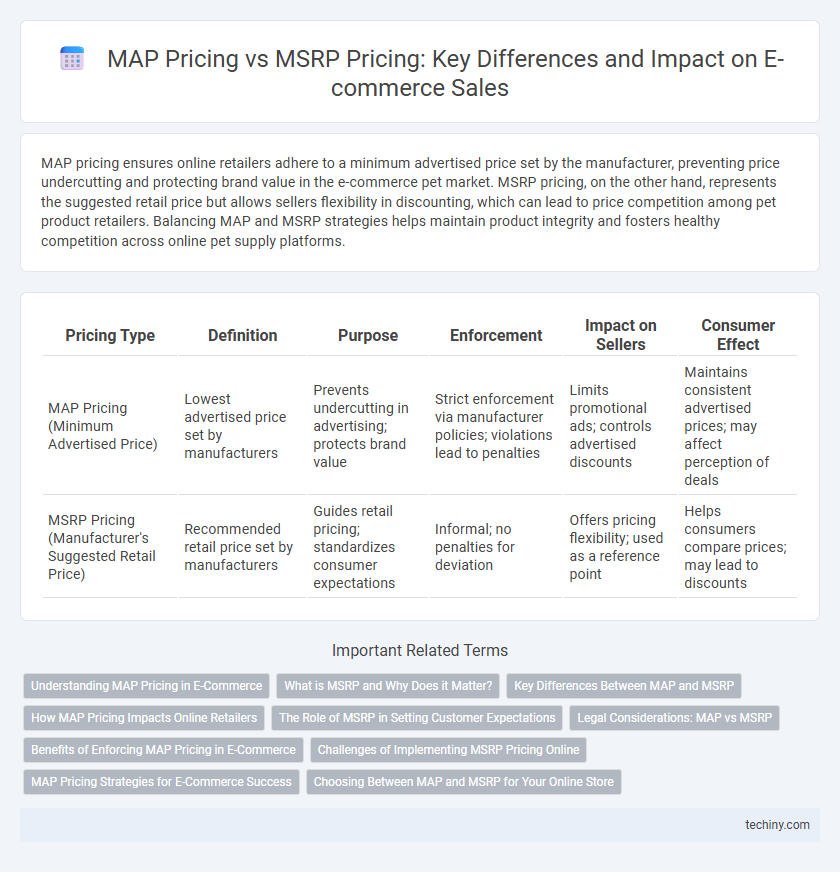MAP pricing ensures online retailers adhere to a minimum advertised price set by the manufacturer, preventing price undercutting and protecting brand value in the e-commerce pet market. MSRP pricing, on the other hand, represents the suggested retail price but allows sellers flexibility in discounting, which can lead to price competition among pet product retailers. Balancing MAP and MSRP strategies helps maintain product integrity and fosters healthy competition across online pet supply platforms.
Table of Comparison
| Pricing Type | Definition | Purpose | Enforcement | Impact on Sellers | Consumer Effect |
|---|---|---|---|---|---|
| MAP Pricing (Minimum Advertised Price) | Lowest advertised price set by manufacturers | Prevents undercutting in advertising; protects brand value | Strict enforcement via manufacturer policies; violations lead to penalties | Limits promotional ads; controls advertised discounts | Maintains consistent advertised prices; may affect perception of deals |
| MSRP Pricing (Manufacturer's Suggested Retail Price) | Recommended retail price set by manufacturers | Guides retail pricing; standardizes consumer expectations | Informal; no penalties for deviation | Offers pricing flexibility; used as a reference point | Helps consumers compare prices; may lead to discounts |
Understanding MAP Pricing in E-Commerce
MAP pricing in e-commerce refers to the Minimum Advertised Price that manufacturers set to prevent retailers from advertising products below a specified price, ensuring fair competition and brand value preservation. Unlike MSRP, or Manufacturer's Suggested Retail Price, which is a recommended selling price, MAP controls the lowest price visible to consumers in advertisements but does not restrict actual sale prices at checkout. Implementing MAP pricing helps e-commerce platforms maintain consistent pricing strategies, avoid price wars, and protect profit margins across multiple retail channels.
What is MSRP and Why Does it Matter?
MSRP, or Manufacturer's Suggested Retail Price, serves as a benchmark price set by manufacturers to guide retailers in pricing products consistently across various sales channels. It helps maintain brand value and consumer trust by preventing drastic price undercutting that can devalue perceived product quality. Understanding MSRP is crucial for e-commerce businesses to strategize pricing, balance competitiveness, and comply with manufacturer agreements.
Key Differences Between MAP and MSRP
MAP (Minimum Advertised Price) pricing sets the lowest price retailers can advertise for a product, ensuring brand value and retailer competitiveness, while MSRP (Manufacturer's Suggested Retail Price) is the recommended selling price set by manufacturers to standardize market pricing. MAP pricing controls advertising discounts but allows retailers to sell below the minimum price privately, whereas MSRP serves as a pricing guideline without enforcement on advertised prices or actual sales. Key differences include MAP's focus on advertising restrictions to protect brand perception and MSRP's role as a non-binding pricing recommendation for consistency across channels.
How MAP Pricing Impacts Online Retailers
MAP (Minimum Advertised Price) pricing directly influences online retailers by restricting the lowest price they can publicly advertise, ensuring brand value and preventing price erosion. This policy helps maintain fair competition among sellers while protecting manufacturers' suggested retail prices (MSRP), thereby preserving profit margins for both brands and retailers. Enforcing MAP pricing online also reduces the risk of price wars and maintains consistent pricing across marketplaces, which enhances customer trust and brand reputation.
The Role of MSRP in Setting Customer Expectations
MSRP pricing establishes a standardized reference point that helps customers gauge the fair market value of products, influencing their purchasing decisions and perceived quality. By clearly displaying MSRP alongside current prices, retailers can highlight discounts and create a sense of urgency, enhancing the perceived value of promotional offers. Consistent use of MSRP supports brand positioning and helps align customer expectations with product positioning in competitive e-commerce markets.
Legal Considerations: MAP vs MSRP
Minimum Advertised Price (MAP) policies legally restrict the lowest price a retailer can advertise but do not control the actual selling price, ensuring compliance with antitrust laws by avoiding price-fixing accusations. Manufacturer's Suggested Retail Price (MSRP) serves as a recommended price benchmark without legal enforcement, allowing retailers flexibility in pricing strategies. Violating MAP agreements may lead to penalties such as loss of supply or legal action, while MSRP violations generally have fewer legal repercussions but can impact brand perception and retail relationships.
Benefits of Enforcing MAP Pricing in E-Commerce
Enforcing Minimum Advertised Price (MAP) pricing in e-commerce helps maintain fair competition among retailers by preventing price undercutting and preserving brand value. It ensures consistent pricing across multiple online platforms, protecting profit margins and enhancing customer trust in pricing transparency. Furthermore, MAP pricing encourages retailers to invest in marketing and customer service, leading to improved brand loyalty and long-term sales growth.
Challenges of Implementing MSRP Pricing Online
Implementing MSRP pricing online presents challenges such as reduced flexibility in adjusting prices to respond to market demand and increased risk of pricing inconsistencies across multiple sales channels. Enforcing MSRP can lead to conflicts with retailers who prefer competitive pricing strategies to attract customers, potentially harming brand reputation and sales volume. Technical difficulties in synchronizing MSRP data across e-commerce platforms and marketplaces complicate maintaining accurate and up-to-date pricing information.
MAP Pricing Strategies for E-Commerce Success
MAP pricing strategies ensure brand value protection and consistent retailer pricing, preventing price wars that erode profit margins in e-commerce. Implementing MAP policies encourages fair competition among sellers while enhancing customer trust through stable price points. Effective MAP enforcement leverages automated monitoring tools to detect violations promptly and maintain marketplace integrity.
Choosing Between MAP and MSRP for Your Online Store
Choosing between Minimum Advertised Price (MAP) and Manufacturer's Suggested Retail Price (MSRP) pricing strategies impacts your e-commerce store's competitiveness and profit margins. MAP pricing enforces a floor on advertised prices, protecting brand value and preventing undercutting among resellers, while MSRP serves as a benchmark price suggested by the manufacturer but allows more flexibility for discounts and promotions. Selecting MAP pricing benefits brands seeking consistent pricing control and reputation management, whereas MSRP offers adaptability to market demand and competitive pricing dynamics.
MAP Pricing vs MSRP Pricing Infographic

 techiny.com
techiny.com